- Preparation
- Universal Gear
- Kayaking Safety Gear
This page contains the General/Universal Safety Gear that can (or should) be used for many different outdoor activities. Additional, more specific gear, can be found on these subject-pages:
Preparation
Outdoor activities need to be carefully planned! Defining elements of each trip are navigation, weather, group composition, gear and a safety plan.
Know your limits.
Whether you’re planning a multi-day hike or a canoe day trip, it is important to be aware of your physical and practical abilities and limits before you head out. Do your research and plan your itinerary depending on your level.
Navigation
Make sure you have enough navigation tools with you. Compass, GPS navigation, Phone navigation apps, Maps, et cetera. Do not rely solely on electrical means. Take actual maps and a real compass!
An important safety measure is to inform others about your plans. Even if you carry a GPS tracker, basecamp, authorities like the local mountain rescue, or others travelling the same route, should be informed about your plans. You can also leave your plans/itinerary under the driver seat of your car. Only inform people you know how to contact and let them know you have finished your trip safely.
Be weather wise.
Keep an eye on current and predicted weather conditions. Weather can change very quickly. Know the signs for approaching storms or changing weather conditions. Use a weather and emergency radio to stay informed. If you carry a handheld walkie talkie VHF radio, set it up to monitor weather frequenties.
Universal Gear
Gear, used for multiple sports:
| Gear | Whitewater Kayaking | Openwater Kayaking | Trekking | Basecamp | Camper |
|---|---|---|---|---|---|
| Personal Locator Beacon (PLB) | X | X | X | X | X |
| Rescue Laser Light | X | X | X | X | X |
| LED Distress Flare | X | X | X | X | X |
| Pyro signals | X | X | X | ||
| Telephone | X | X | X | X | X |
| Radio & Walkie Talkies | X | X | X | ||
| Weather & Emergency Radio | X | X | |||
| Emergency Shelter | X | X | |||
| Wood Saw | X | X | X | X |
Zoleo satellite communicator / Personal Locator Beacon (PLB)
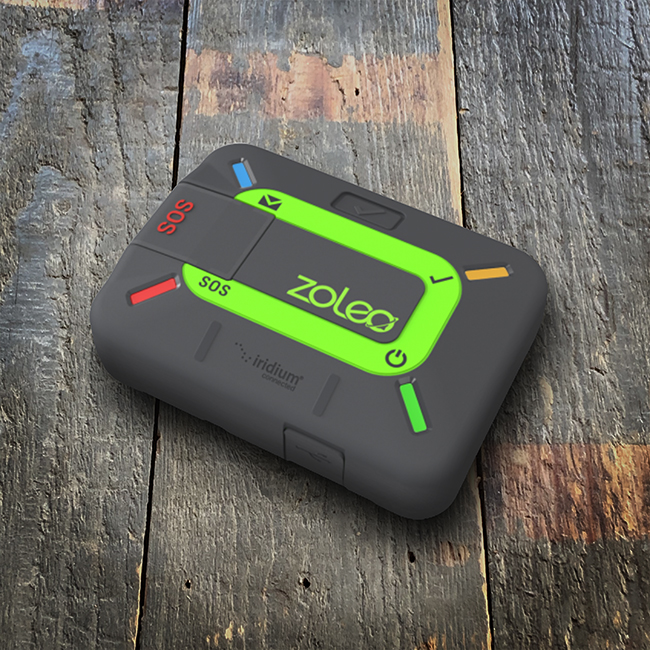
The first item I pack (for personal ánd group safety) on every outdoor activity is my Satellite Messenger / Personal Locator Beacon (PLB). In the context of white water kayaking it’ll primarily be my PLB. The Zoleo satellite communicator, can send an SOS alert to activate Search & Rescue, with 24/7 emergency monitoring and dispatch included (provided by GEOS). Both the device and the app have a dedicated button for this.
Not to be used lightheartedly as it will result in the activation of a (helicopter) rescue team, guiding them to your location: When GEOS receives your SOS alert, they’ll know the GPS coordinates of your ZOLEO communicator. They’ll contact the appropriate emergency response authorities for your location, and reach out to the emergency contacts you designated when creating your ZOLEO account.
Using the ZOLEO App, you’ll also be able to message back and forth with GEOS to exchange updates, until your emergency situation has been resolved. Two-way SOS simply isn’t offered by one-way communicators, PLBs and EPIRBs. Even if you’re using the ZOLEO communicator on its own, without the app, you’ll get confirmation that your SOS message was received (via the LEDs on the device).
Most relative techspecs: weight: 150g, IP68 water-resistant to 1.5 m for 30 min, battery life: 200+ hours.
Besides that, the Zoleo will:
- Send and receive messages anywhere over Wi-Fi, cellular and satellite, trying in the following order: Wi-Fi, cellular data, then over the Iridium satellite network, via the ZOLEO device. (Basically the least cost route for the message.)
- Messaging is possible by SMS, email and app-to-app.
- Send Check-in messages with one touch, to let others know you’re OK. Both the device and the app have a dedicated button for this. Your check-in message will be sent to your check-in contact(s). You can also include your GPS coordinates if desired.
- Get DarkSky weather forecasts.
- Share your GPS location with others, via messages. (The Zoleo doesn’t provide a following/tracking feature.)
Rescue Laser Light
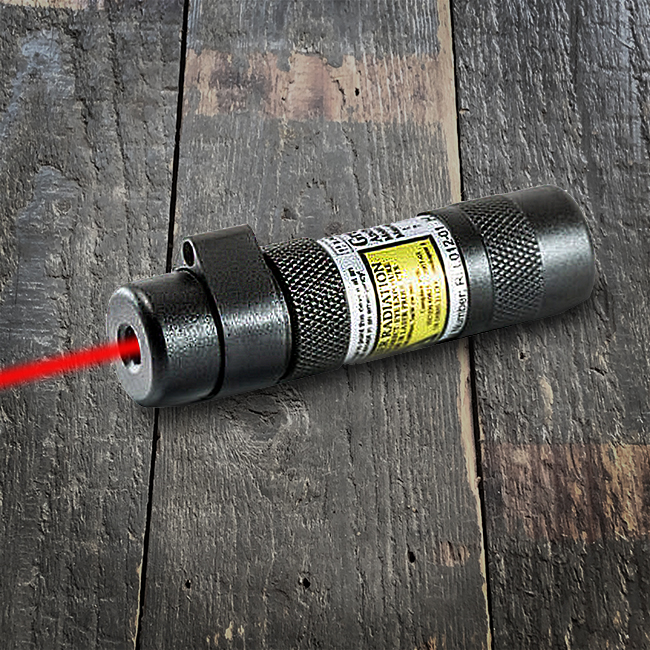
This is my Rescue Laser Light. A Laser Light is a hand-held day and night laser signaling device that provides a convenient, effective way to signal a rescue party. Unlike normal lasers, the Rescue Light isn’t beaming a dot. It beams a vertical fan of light that spreads thousands of feet long at miles of distance, making it easy to get the attention of rescue people, – vehicles or -aircrafts. A target will see a brief, but bright, momentary flash as the laser line crosses their field of vision. At distances of 13 feet or more, the Rescue Laser is perfectly eye safe, yet incredibly effective up to 30 miles away. It’s waterproof, rugged design combines the safety of a laser signaling device with the convenience of a flashlight. The Rescue Laser Light is non-flammable, environmentally safe, and can operate continuously for 40 hours on a single, long-life, replaceable CR123 lithium battery. It has a Sight Ring to help aim at your target.
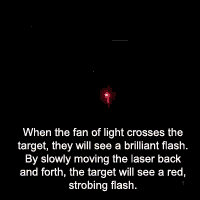 | Visibility: 32 km nighttime, optimum conditions and 1.6-4.8 km daytime Waterproof: to 24 m Operational Life: 40 hours continuous use before changing battery Battery: CR123 lithium battery Class 3R laser device < 5mW |
Odeo LED Distress Flare
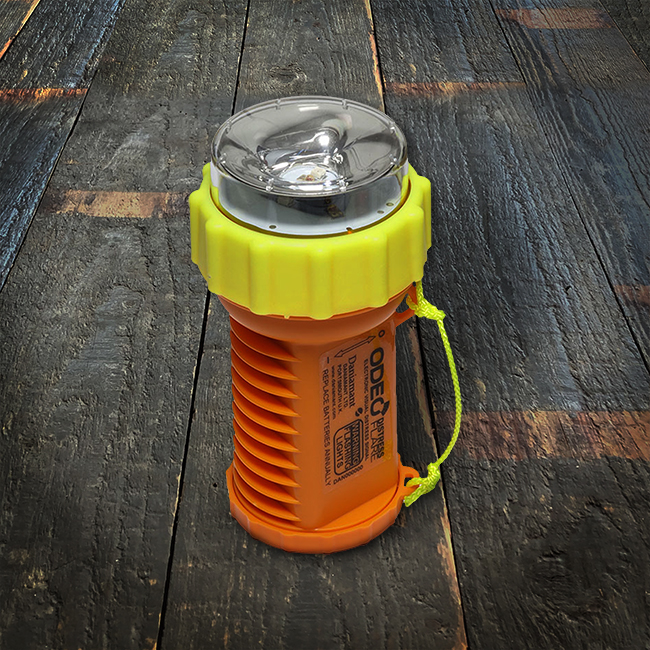
The Odeo LED Flare (an Electronic Visual Distress Signal Device or eVDSD), is an internationally recognised distress signal and fully SOLAS (Safety of Life at Sea) compliant.
Flares are used to attract the attention of rescue teams. The small size (122x64mm), low weight (150 grams including batteries) and the IP68 rating of this flare makes it an ideal device for mountaineering, skiing, kayaking and other outdoor activities, where an unobstructed views (such as high ground) is available. Thus, this floating LED flare can replace the conventional smoke beacons and handheld flares on big water or open terrain, but it cannot replace rocket/parachute flares in situations like a mountainous or densely wooded landscape.
The Odeo Distress Flare has both Superbright LED’s and Infra Red LED’s (for night vision goggles), offering both strobe and SOS signals. It uses four L91 Lithium batteries for optimal functionality, which allow it to illuminate for around 9 hours at full illumination (pyro flares, typically, will illuminate for around 60 seconds), they are safer and can even be carried in baggage on flights.
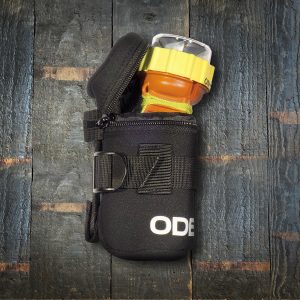
Pyro signals
Wether you go kayaking, paragliding, hill-walking, climbing, skiing and or any other outdoor adventure, you’ll need to think about safety. Pyro signals are among the possible aids at your disposal. Here’s what I have and use:

Rocket/Parachute Flare
Handheld Flare
Compact Distress Signal
Smoke Beacon
When in distress and in the right conditions (we do not want to cause a uncontrolled fire), a fire can be helpfull in many ways. For attracting attention, place a fire on high ground, preferably within hearing distance. When out of hearing distance, leave an arrow pointing towards your location. When sight is compromised by rain, mist or clouds, the smell of a fire will give an indication of your location. I pack a lighter and a couple of strips of inner tube. They are argueably the quickest way to make a lasting, smoking and stinking rescue fire.
The bare minimum that one should take when going into the outdoors are Compact Distress Signals. These signals, used to reveal your location when rescue services are sighted, are for day or night-use. I have replaced these for a Led Distress Flare.
A Handflare Mk8 can help helicopter pilots to pinpoint casualty location and give vital information about wind speed and direction. It burns for 60 seconds at 15.000 candela. 176g (6.2 oz) I have replaced these for a Led Distress Flare.
Rocket/parachute flares like my Para Red Rocket Mk8A are set off from the hand, can reach a height of 300 metres (about 1,000ft). Personal/rocket flares have that initial height (can be seen from further afield), a bang, which may grab attention if there’s anyone around. Burning for 40 seconds at 30.000 candela. 235 g (8.3 oz).
I no longer pack Smoke Beacons. I have replaced these for a Led Distress Flare.
Telephone & Radio Contact.
Pre Contact
What you preferably know before making Phone/Radio Contact, in order to give rescue services as much information as available:
- Location: Many of the gear we carry around can provide this information, check your maps, telephone, camera, watch and any gps-enabled aparatus. Give them landmarks. Is there a road in sight? Is there a 50×50 meter clearing close by for a helicopter to land? Tell them if you have flairs, beacons, makeshift signs and such. Tell them your last know location, general direction and time since.
- Emergency. Give as much information as possible about why this is an emergency:
- Wounded people? Immobile, bleeding, in shock?
- Stuck, pinned, lost, dead people?
- Lost? Give them landmarks. tell them if you have flairs, beacons and such. tell them your last know location, general direction and time since.
- Urgency. Why is help time-sensitive. Wounded people, pinned people, weather closing in.
International Emergency Telephone Codes & Mountain Rescue Services
Please help me fill this chart with the correct information!
| Country | Phone number | Radio Channel & Frequencies |
|---|---|---|
| Austria | 140 / 144 / 112 | No Radio Call available |
| Bulgaria | (088)1470 / (02)9632000 | 55.475 Mhz or 147.850 Mhz |
| England, Wales, Scotland | 999 / 112 | Radio call frequency restricted to the emergency services |
| France | 112 transfer the calls to the mountain rescue unit. | 150 MHz range |
| Germany, Bavarian Alps, low mountainrange | 112 | Radio call frequencies restricted to the emergency services |
| Italy | 118, activation of HEMS or mountain rescue teams | For mountain rescue only 71.500 / 71.550 MHz, not available for the public. |
| Netherlands | 112 | VHF Channel 10, Freq. 156.500 |
| Norway | 112 (police) / 113 (health service) | Channel 5. Restricted to professionals |
| Poland | 112 / 601100300 | Radio frequency 153.625 MHz |
| Slovenia | 112 | Usually 157.725 MHz (not for public use) |
| Spain | 112 / 062 | Radio call frequency, if there is one available: 146:175 MHz. |
| Switzerland | 144 / 1414 / 112 | 161.300 MHz |
Telephone
Mobile Phone Voice
Use the telephone numbers in the list on top of this page. This is the best option if available and must take priority over any other communication method you may have at your disposal.
Emergency Calls Only
If your phone is showing ‘Emergency Calls Only’, this means that you will be able to make a emergency call. However, you will not be able to receive incoming calls. Inform the operator of this, as the police and/or Mountain Rescue Team will need to call you back. If someone else in the group has a phone that is not showing ‘Emergency Calls Only’, use their phone for the emergency call, as it will allow incoming calls.
Saving Mobile Battery
The primary function of your phone when on a kayak trip, should be for communication in an emergency. In remote areas battery drain can be rapid, and quicker than urban locations, for a variety of reasons, and the following steps will ensure that you have sufficient battery if you do need to make a call.
- either switch off your mobile, or set it to ‘flight’ or ‘aircraft’ mode. Flight mode switches off the phone’s search for a mobile network, and thus prevents battery drain.
- make sure all unnecessary smart phone apps are closed down.
- switch off data, Bluetooth and GPS connections unless required. Some phones allow activation even when in flight mode.
- store your phone in your rucksack and in a waterproof bag or container, but be sure in the prevailing conditions that the ring-tone can be heard (if called for emergency services).
Mobile Phone Text
If the signal is shaky or very weak, try SMS/text. Text and await a reply. You must have registered with the service before using. Include your number in case text is onward relayed.
WalkieTalkie/Radio Contact
Sena Expand Mesh
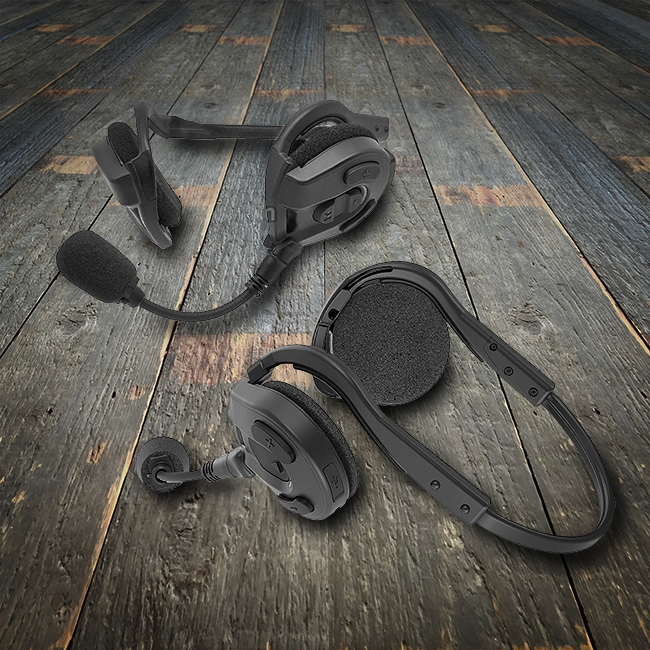
The Sena Expand Mesh is a compact communication headset equipped with technology allowing for easy group communication. This is a fun piece of gear for kayaking/canoeing, trekking, rock climbing, horseback riding, fishing, hunting, paragliding, biking and many other sports. But it can be of great importance in situations that demand group communication. These headsets can be used iwth mobile phones, but they also have a mesh technology that allow direct communication over 900 meters. This is a great function for staying out of trouble!
In addition to the built-in intercom system, the Expand Mesh also allows for Bluetooth connection with a smartphone. So you can listen to music, hear GPS directions, cues from fitness apps, or even take a phone call. The Audio Multitasking allows users to listen to audio from a smartphone and still be able to communicate over the Mesh Intercom system without disrupting the conversation. The Expand Mesh is also compatible with the Sena Outdoor App, which allows for setting up intercom groups, adjusting device settings, and accessing the device’s Quick Start Guide on-the-go.
Designed to wear comfortably with hats, helmets, or sunglasses.
Walkie Talkies
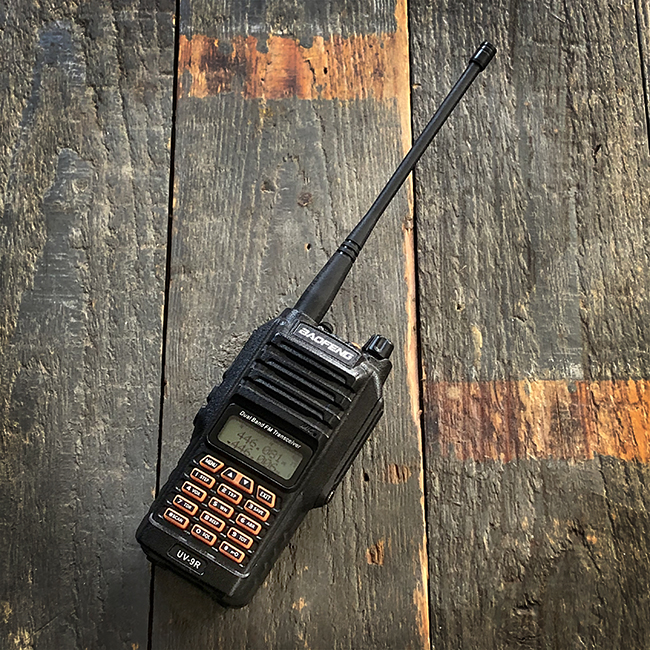
Ideal for group communication as well as in habitated areas and when navigating open water as these can be used on frequencies used by ships as well. You will know if someone has received your message. VHF radios sometimes require an operator to be licensed. But, if the means is available and there is genuine distress, it should be used.
Radio Communications Techniques
There are a few simple practices that can make a big difference in the effectiveness of radio communications. Handheld radios should be held away from the body with the radio and antenna in a vertical position. If the antenna is in contact with the operator’s body, the RF signal strength will be reduced. Holding the radio and its antenna as high as possible will increase the line-of-sight range. The antennas on both transceivers in a radio link need to be in the same plane, or polarization. For VHF/UHF mobile radios, handheld radios, and repeaters, the polarization is always vertical. Having the antennas in different polarities can result in up to a 100-fold loss of signal strength. To transmit a message, hold the radio 5 to 10 centimeters from the face and listen for several seconds to ensure the frequency is available. Press and hold the push-to-talk button for 1 second before speaking, this prevents the first word or two of the message from being dropped. Speak slowly and clearly in a normal pitch, using normal vocabulary. It is often a good idea for the receiving station to repeat radio messages back to the sending station to ensure that the message was correctly understood, particularly if the signal is weak or garbled. One should assume that all radio transmissions are being monitored and that anything said on the radio is being said in public.
Weather & Emergency Radio
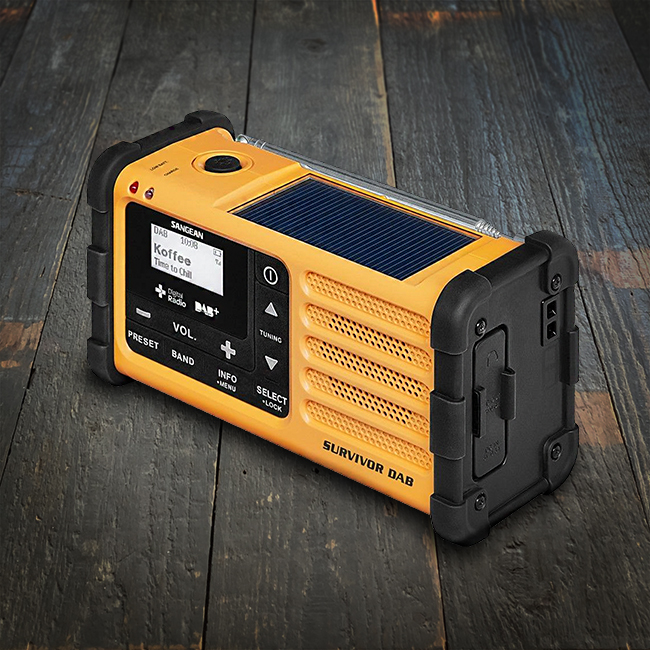
Basecamp, Camping or at Home, as soon as the internet is not available an Emergency Radio can get you the needed information about weather, disasters and what not. But, radio’s need power, so I use the Sangean Survivor because it accepts Micro USB, the hand crank and the solar panel to charge it. You can see if the device is charging with the LED indicator. This radio offers both analogue FM reception and it’s digital successor DAB+. So all you have to do is check the emergency frequencies in your area. The radio will also play your music via speaker or earphone, charge your phone, it has a clock, 20 station presets (10 DAB+, 10 FM) and it has a flashlight with Morse Code SOS.
Sangean Discount Code!
Visitors of my website are offered a €20 reduction on the Sangean website ánd after registration the standard two year guarantee is upgraded to five years. All you have to do is use the reduction code: Whitewatergear
(No, I do not get paid, nor do I get a return fee.)
Emergency Shelter
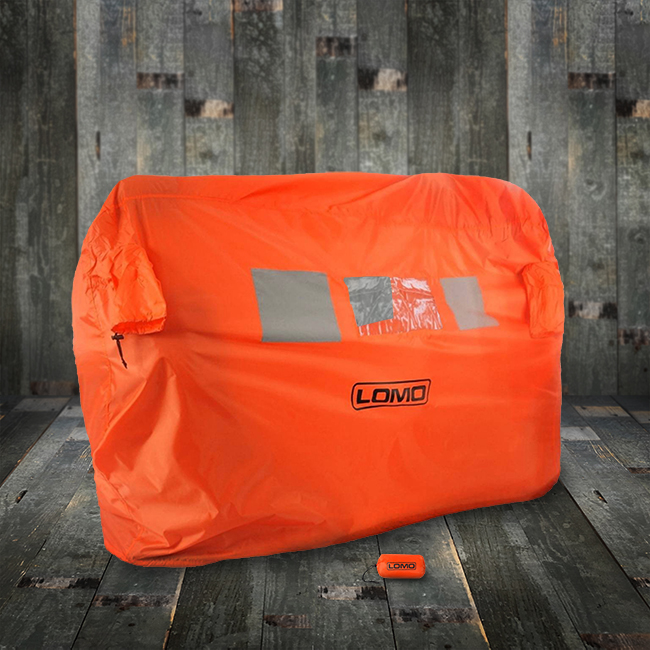
My Lomo Emergency Storm Shelter is a 2-3 man ‘Bothy Bag’. It provides protection from the wind and rain, lightweight, easy to carry and can be pulled over 2-3 people to help keep the elements off them in an emergency. High-viz orange, PU-coated polyester, two large retro reflective patches reflecting, a viewing window and two clossable air-vent snorkels aid ventilation. Packs as small as 21cm x 10cm and weighs 360 grams.
Wood Saw
For clearing your way through a blocked river or freeing a trapped paddler. I use a Silky Pocket Boy, with 170/10 blade.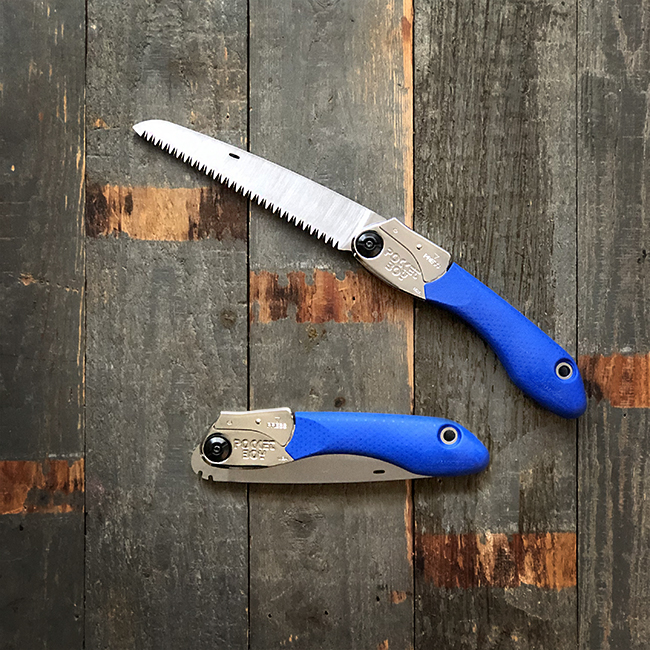
Kayaking Safety Gear
Spare paddle
At least one member of the group should carry a spare paddle. Any decent splittable paddle will do.
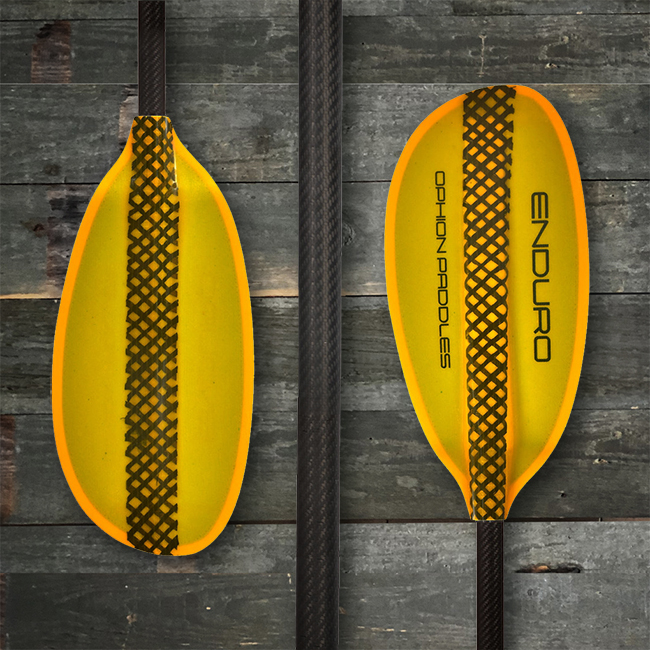 Ophion Enduro Whitewater Paddle | 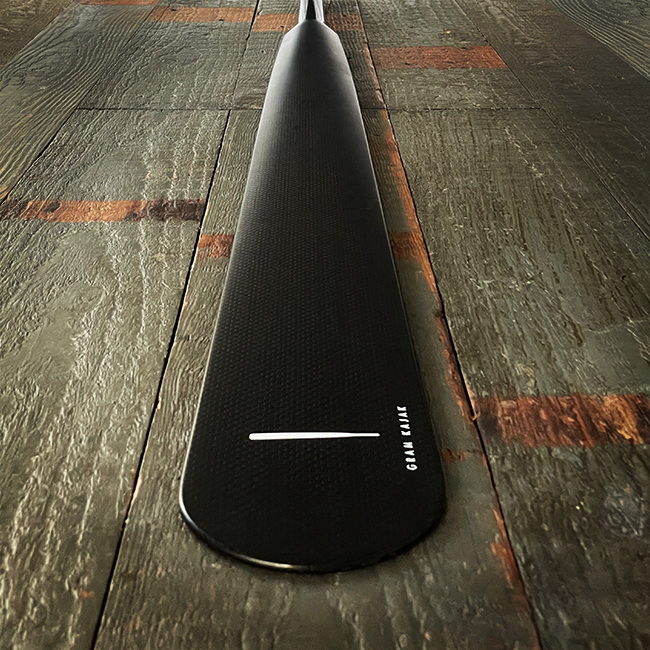 Gram 900D Carbon, Greenland Style Paddle |
Whistle
For communicating on whitewater, when your voice isn’t strong enough. I use an Acme Tornado 2000 professional referee stadium whistle, which blows out any water easily and has loads of volume (up to 122 decibel).
